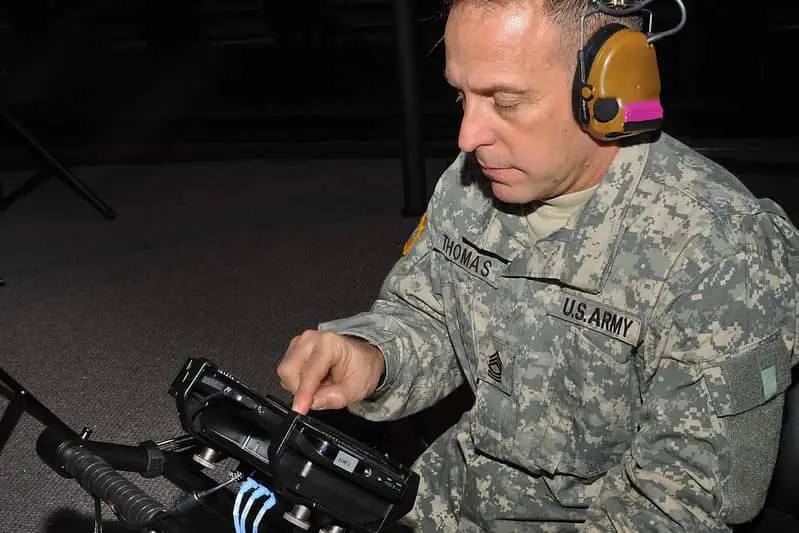
Soldiers do wear ear protection when in the field. Soldiers can choose to wear foam earplugs, Triple-and quad-flange earplugs, tactical earplugs, noise muffs, and TCAPS. TCAPS are the best ear protection device for soldiers and the US Army is using them more often.
A soldiers’ ability to hear and communicate, especially in a tactical environment, is of utmost importance. Hearing is one of the main human senses and is critical for situational awareness in the battlefield. The ability for soldiers to take on or give orders in a loud environment is key for success.
Table of Contents:
1. Soldiers’ Dilemma with Wearing Traditional Ear Protection
2. Current Ear Protection Options For Soldiers
3. How Do Soldiers Check to See If Their Ear Protection Is Working
4. Why Are TCAPS The Best Ear Protection For Soldiers
Soldiers’ Dilemma with Wearing Traditional Ear Protection
Traditional methods of ear protection such as foam earplugs are only effective in certain and stable environments. However, the practical use of foam earplugs or tactical earplugs are poor since it inhibits your situational awareness and most soldiers often abandon them in order to effectively communicate with each other.
A soldier is surrounded by loud noises. Loud sounds on the battle field can come from:
- Firing of weapons
- Being on the receiving end of a shooting
- loud machinery
- Sirens
- Soldiers yelling trying to communicate to one another
- Listening to commands from officers.
This can have negative consequences as soldiers are bombarded with loud noises, yet still need to listen for other important situations on the field such as an enemy approaching or taking commands from officers.
Soldiers tend to simply remove their earplugs and use old methods such as covering their ears when weapons are fired in order to hear their fellow soldiers, commanders, and listen to the enemy (especially at night).
Soldiers not wearing the right ear protection on the field can cause real problems. Tinnitus is the most common military disability that veterans face, with hearing loss being the second most common disability among veterans (source). Tinnitus is when you experience constant ringing noise in one or both ears. This isnt because there actually is an external sound, and people who don’t have it do not hear this ringing sound that a person who has tinnitus hears (source).
To make matters worse, a lawsuit was filled against 3M claiming it knowingly sold defective earplugs to soldiers from 2003 – 2015. This was caused by a design flaw in the earplug with many soldiers reporting constant ringing in their ears (source).
So should soldiers sacrifice their hearing and potentially injure their ears in order to communicate? What can soldiers really do to find a balance between protecting their ears while still be able to communicate and have that situation awareness? Let’s find out.
Current Ear Protection Options For Soldiers
According to the department of defence hearing center of excellence, here are the 5 options for soldiers to protect their ears and hearing (source).
1. Foam Earplugs

These are the most common type of ear protection. They’re readily available at any convience store and are typically used when working with home equipments or concerts.
How should soldiers use foam earplugs?
- Roll and compress the foam earplug
- Compress until small enough to fit your ear canal
- Using your other hand, reach over your head and pull up and back on your ear
- Use your other hand to slide in the ear foam so that it fits in properly and comfortably
- The ear foam will expand on its own when it slides in.
Advantages of Foam EarPlugs:
– Readily available
– Can be fit in quickly
Problem with Foam EarPlugs:
– Typically used as a one time solution
– Do not provide situational awareness in the battlefield
2- Triple- and quad-flange earplugs
Tripple and quad flange earplugs are typically used in machine rooms or when doing around the house work such as mowing the lawn. They require initial fitting by a medical professional. They are reusable and provide protection in steady state noise exposure, when communication is not required.
Advantages of Triple-and-quad-flange earplugs:
– Reusable
– Provide protection from steady-state noise exposures
Problems with Triple-and-quad-flange earplugs:
– They do require a once-a-year- examination by a medical professional to asses the fitting of the earplug since our ear canal changes as we age
– Can’t be used in a situation where communication is required
3- Tactical Earplugs
Tactical earplugs are also a resuable option for ear protection for soldiers. They protect soldiers from steady state noise exposure and allow for communication when the switch is open. When the switch is opened, it allows the soldier to listen to soft sounds such as speech but also protects the soldier from loud and harmful noises.
Advantages of Tactical Earplugs:
– Balances ear protection while allowing for situation awareness
Disadvantages of Tactical Earplugs:
– Still require annual fitting by medical professional
4. Noise Muffs
Noise muuffs look like an everyday headphone except it is much thicker. They do a good job at protecting a soldiers hearing as long as the fitting is right. it prevents noise from entering the ear canal. Soldiers typically wear them in shooting ranges, but they can also be used on a flight line or any other situation where communication is not really necessary.
Advantages of Ear Muffs:
– Easy to put on and take off
– Does not require fitting by medical professional
– Provide more ear protection than earplugs
– Readily available
Disadvantage of Ear Muffs:
– Hinders a soldiers ability to communicate
– Can’t be used in tactical environments
5- Tactical Communication and Protective Systems (TCAPS)
These are the newest and most proven technology for ear and hear protection for soldiers. These are smart earplugs that significantly reduce the hearing of steady state noise exposure while still alowing soldiers to communicate comfortably.
It works by actively reducing the sound of loud noises. The louder the outside noise is, the more it turns the volume down (source). The soldier wearing the device can still hear sound but it will never be too loud or damaging. At the same time, the device can increase the sound of soft sounds such as speech.
In 2014, the U.S Army began gradually deploying the latest version of this hearing protection system (source).
How Do Soldiers Check to See If Their Ear Protection Is Working
Here are a few ways soldiers can check if their ear protection is working:
1- Tug test – After inserting the earplug, their should be resistance when pulling the earplug outwards gently. This ensures that the earplug is air tight.
2- Covering the ears with your hands and removing them after the insertion of the earplug should determine whether they’re working. The difference in sound volume should not be noticeable.
3- Your own voice should be heard in the center of your head
Why Are TCAPS The Best Ear Protection For Soldiers
TCAPS meets the requirement of soldiers’ hearing requirements by doing the following:
1. Bone Conduction Microphone Integration
2. Hearing Protection & Enhancing Situational Awareness
3. Water proofing
1- Bone Conduction Microphone
INVISIO, the manufacturer of TCAPS, use a patented bone conduction technology. This allows the small in-ear microphone to pick up sound vibrations from the soldiers’ jawbone. These vibrations are then converted into sound. This ensures that speech and even whispering are clearly communicated to the user (source).
This method of bone conduction for sound replaces the traditional methods of ear protection devices that rely on reduction of overall sound wave technology.
2- Hearing Protection & Enhancing Situation Awareness
In order to balance out the reduction of loud steady state noises (such as loud machinery and firing of gun shots) INVISIO uses advanced digital signal processing. This helps miniaturise audio components. The ergonomic headset design helps to provide the most natural hearing possible – even in extreme conditions (source).
3- Water Proofing
Soldiers are not always certain where and when they will be operating in a tactical environment. The terrain is also unkown and soldiers may find themselves exposed to water. Therefore, the TCAPS are designed to be water proof down to 20 meters. They are submersible in water thanks to the complete sealing of the device (source).

